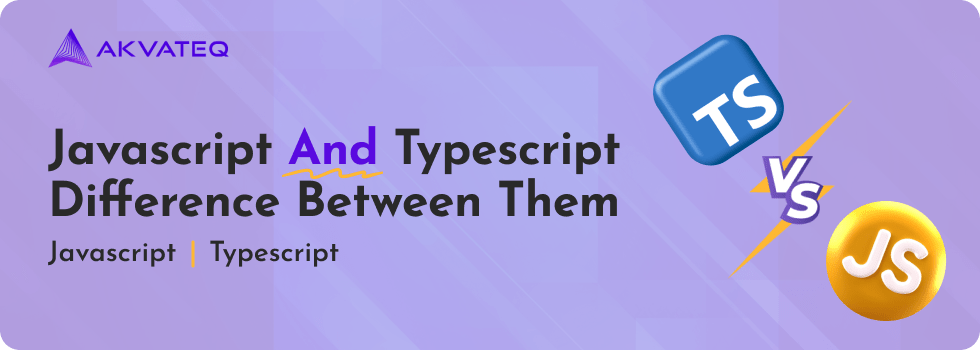JavaScript and TypeScript may seem alike, yet a critical contrast sets them apart.
The crucial difference lies in the presence of a type system. JavaScript allows variables to change their form unpredictably, whereas TypeScript, especially in strict mode, prevents this. This characteristic makes TypeScript more straightforward to work with.
.
JavaScript and TypeScript: Understanding the Differences
JavaScript is a dynamic programming language widely utilized for web development, web & mobile applications, game development, and various other purposes. With its dynamic nature, it enables the implementation of interactive and dynamic features on web pages, contributing to enhanced user experiences.
Javascript was invented by Brendan Eich in 1995, and in 1997 it became an ECMA standard. Java script was Introduced as the client-side programming language. However, it starts growing and its code becomes complex and heavy. Due to these limitations, JavaScript struggled to fully meet the requirements of a robust Object-Oriented Programming (OOP) language. JavaScript’s dynamic typing and interpreted nature prevented it from succeeding at the enterprise level as a server-side technology.
TypeScript was developed as an open-source programming language by Microsoft and its first release was on October 2012. It can be considered as a superset of Javascript, which means that all the javascript is valid for Type script, but TypeScript adds optional static typing to JavaScript such as defining the types for variables, parameters, functions, and return values, early error detections and better code quality.

get in touch to discuss your project
JavaScript and TypeScript indeed share similarities, but a crucial difference sets them apart.
The main difference between JavaScript and TypeScript lies in the presence of a type system. JavaScript lacks static typing, allowing variables to change their form unpredictably. On the other hand, TypeScript, particularly in strict mode, prohibits such behavior, bringing more predictability and stability to the codebase. This makes TypeScript a more manageable and maintainable choice, particularly when dealing with extensive projects.
From TypeScript to JavaScript
TypeScript is an upgraded and more advanced way to write JavaScript.
To use TypeScript code in an application, you first need to convert it into regular JavaScript. TypeScript is designed to help you create JavaScript code that works well with all kinds of web browsers.
Think of TypeScript as a tool that generates JavaScript. It allows you to create JavaScript code that can run in any environment that supports the standard JavaScript language.”
Criteria | JavaScript | TypeScript |
Release year | 1995 | 2012 |
Created by | Brendan Eich | Microsoft |
Trademark owner | Oracle | Microsoft Corporation |
Standard | ECMAScript 5 | ECMAScript 2015 |
Typing | Dynamic | Optional strong typing |
Community and adoption | Larger than TypeScript | Smaller than JavaScript |
Compilation | Not required | Compiled into JavaScript |
File extension | .js and .jsx | .ts and .tsx |
IDE support | Limited validation and refactoring capabilities | Extensive validation and refactoring capabilities |
Complexity | Easy scripting language for new developers to learn | Additional features require an investment of time to learn |
Readability | Large code bases are harder to read and decipher | Type system and object-oriented approach improve readability |
Compatibility | All JavaScript code is also valid TypeScript code | TypeScript code gets compiled into fully compliant JavaScript |
Challenges That Developers Face While Using Java Script
- Developers often face several challenges while using JavaScript compared to TypeScript.
JavaScript is a dynamically typed language, which means that the type of a variable is not known until runtime. This can lead to errors at runtime, as the compiler cannot check for type mismatches. TypeScript is a statically typed language, which means that the type of a variable is known at compile time. This allows the compiler to check for type mismatches, which can help to catch errors early on.
Lack of Static Typing: JavaScript is dynamically typed, which means variables can hold any type of value. This can lead to subtle bugs and errors, as the type of a variable can change unexpectedly during runtime
Javascript code :
function sum(num1, mun2) {
// num1 and num2 can be any type of value
return num1 + num2;
}
// This code will compile and run, but it may not do what you expect
let result = sum(“10”, 20); // The result will be the string “1020”
TypeScript Solution: TypeScript provides optional static typing, allowing developers to define types for variables, function parameters, and return values. This early type checking catches errors during development and improves code robustness.
TypeScript Code:
function sum(num1: string,num2: number) {
// The type of num1 is string and the type of num2 is number
return num1 + num2,
}
With type annotations, the compiler would be able to detect the error at compile time and prevent it from occurring at runtime
- Reduced Code Maintainability: JavaScript’s dynamic nature can make it difficult to understand code, especially in larger projects, as the type of a variable is not evident from the code itself.
Java script code :
function sum(num1, num2) {
// The type of num1 and num2 is not evident from the code
return num1 + num2;
}
TypeScript Solution: TypeScript’s static typing improves code maintainability by providing clear type information. This makes the codebase more self-documenting and helps developers understand how data flows through the application
// TypeScript
function sum(num1: number, num2:: number) {
// The type of num1 and num2 is explicitly specified
return num1 + num2;
}
- Lack of Code Predictability: JavaScript’s weak typing and implicit type coercion can lead to unpredictable behavior, especially when working with different data types.
TypeScript Solution: TypeScript’s strict type checking reduces unexpected behavior by disallowing implicit type conversions and catching type-related errors at compile time.
- Build Process: Incorporating TypeScript into a project requires additional build steps for type checking and compilation.
TypeScript Solution: Modern build tools and frameworks like Webpack and Babel can seamlessly integrate TypeScript into the build process, making it easier to adopt TypeScript in existing projects.
/ In your project at package.json file, add the following dependencies:
“devDependencies”: {
“typescript”: “^4.6.1”,
“webpack”: “^5.63.1”,
“webpack-cli”: “^4.9.3”
}
// generate a webpack.config.js file and add the following line of code:
const webpack = require(“webpack”)
const path = require(“path”)
module.exports = {
entry: “./src/index.ts”,
output: {
path: path.resolve(dirname, “dist”),
filename: “bundle.js”
},
module: {
rules: [
{
test: /.ts$/,
use: “ts-loader”
}
]
},
resolve: {
extensions: [“.ts”, “.js”]
}
};
- Learning Curve: TypeScript has a steeper learning curve than JavaScript, as TypeScript introduces new concepts such as type annotations and interfaces. However, the learning curve is not insurmountable, and the benefits of using TypeScript can outweigh the learning curve.
Benefits of Using Type Script Against Java Script
TypeScript provides numerous advantages over JavaScript, making it an attractive option for developers, particularly in larger and more complex projects. Below are some of the key benefits of TypeScript when compared to JavaScript.
- TypeScript introduces optional static typing, which means that developers can choose to define the types of variables, function parameters, and return values. This can help catch type-related errors early during development and provide better code understanding and maintainability.
- With static typing, TypeScript code tends to have fewer runtime errors. This is because the compiler can check for type mismatches at compile time, which can help to catch errors before they occur at runtime. This leads to improved code quality and reliability.
- Static typing can also enhance code documentation by providing information about the types of variables and expressions. This can make it easier for other developers to understand the code and make changes to it.
- TypeScript’s static typing enables powerful IDE support that can help developers write code faster, navigate through code more easily, and refactor code more effectively. This can significantly improve developer productivity and make it easier to work with large codebases.
- TypeScript supports the latest ECMAScript features, which can be compiled down to older versions of JavaScript to ensure compatibility with different environments.
Practical Tips for Using Type Script Over Java Script
Here are some practical tips for using TypeScript over JavaScript.
- Type annotations can help to improve code readability, documentation, and safety. When you use type annotations, you are explicitly stating the types of variables, functions, and expressions in your code. This can help other developers to understand your code more easily, and it can also help to prevent errors at runtime.
- Interfaces can help to create reusable code and ensure that code is consistent. Interfaces define the behavior of a type, but they do not specify the implementation of that type. This can be helpful for creating libraries and frameworks that can be used with different implementations.
- IDEs with TypeScript support can provide code autocompletion, code navigation, and refactoring tools. This can help to improve developer productivity and make it easier to work with TypeScript code.
- TypeScript can help to prevent errors at runtime. For example, if you try to add a string and a number in JavaScript, the code will compile and run, but the result will be unexpected. In TypeScript, you can use type annotations to specify that the variables are of the correct types, and the compiler will prevent you from adding a string and a number.
- TypeScript can help to improve code readability. For example, if you have a function that takes a number as a parameter, you can use a type annotation to specify the type of the parameter. This can help other developers to understand what the function expects as input, and it can also help to prevent errors.
get in touch to discuss your project
Conclusion
In conclusion, JavaScript and TypeScript are two closely related yet distinct technologies with their unique strengths. JavaScript, being the foundation of web development, lacks a type system, that allows variables to change dynamically. On the other hand, TypeScript, an enhanced version of JavaScript, brings the benefits of a robust type system, offering better code organization and error detection.
TypeScript’s type-checking capabilities provide early detection of potential bugs, making it more maintainable and efficient, especially in large codebases. However, JavaScript remains a versatile and widely adopted language that suits simple projects and rapid development.
The choice between TypeScript and JavaScript ultimately depends on the project’s complexity, the team’s preferences, and the specific development requirements. Both languages play crucial roles in shaping the modern web ecosystem and understanding their differences empowers developers to make informed decisions to meet their objectives.



















